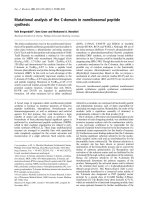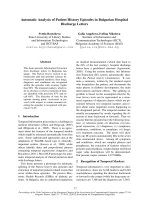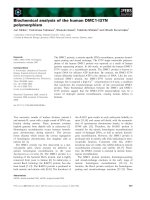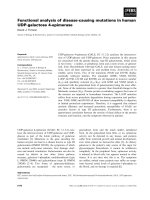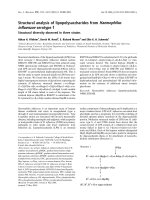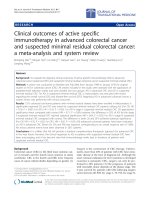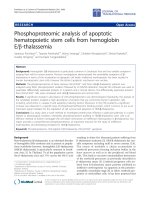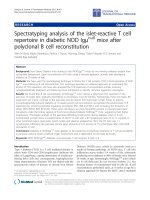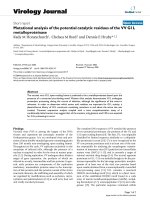Báo cáo sinh học: "Chromosome analysis of horse oocytes cultured in vitro" pot
Bạn đang xem bản rút gọn của tài liệu. Xem và tải ngay bản đầy đủ của tài liệu tại đây (1.86 MB, 10 trang )
Original
article
Chromosome
analysis
of
horse
oocytes
cultured
in
vitro*
WA
King
1
M
Desjardins
2
KP Xu
1
D
Bousquet
3
10YC,
University
of
Guedph,
Department
of Biomedical
Sciences;
2
0YC,
University
of
Guelph,
Department
of
Clinical
Studies;
Guelph,
Ontario,
N1G
2Wl,Canada
3 Centre
dins6mination
artificielle
du
Qu6bec
Inc,
3456
Sicotte
St-Hyacinthe,
Quebec,
J2S
2M2
Canada
(Received
23
October
1989;
accepted
22
February
1990)
Summary -
Oocytes
collected
from
slaughtered
mares
of
unknown
reproductive
history
were
cultured
in
modified
Krebs
Ringers
bicarbonate
supplemented
with
fetal
calf
serum
(20%)
and
fixed
for
chromosome
analysis.
To
determine
the
time
required
for
nuclear
maturation,
oocytes
were
fixed
either
after
12
h
(n
=
21) 24
h
(n
=
21),
48
h
(n
=
20)
and
60-96
h
(n
=
12)
or
without
culture
(n
=
30).
In
all
89%
of those
suitable
for
analysis,
meiosis
was
resumed
with
59%
reaching
second
metaphase
(MII)
stage.
In
the
majority
of
oocytes
germinal
vesicle
breakdown
occurred
by
the
end
of
the
1st
12
h
of
culture
and
MII
was
reached
by
24
h.
To
examine
the
chromosome
features,
an
additional
113
oocyte-
cumulus-complexes
were
cultured
for
24
h
before
fixation.
In
all,
7
diakinesis/metaphase
I
(MI)
and
36
MII
spreads
could
be
analyzed.
Of
the
Mll
spreads,
5
(13.8%)
were
found
to
be
lacking
chromosomes,
1
(2.7%)
had
an
excess
of
chromosomes
and
1
(2.7%)
was
diploid.
Compensating
for
possible
artifactual
loss
of
chromosomes,
the
rate
of
non-disjunction
or
anaphase
lagging
was
calculated
to
be
5.5%
It
was
concluded
that
with
respect
to
timing
and
chromosomal
features,
nuclear
maturation
of
in
vitro
cultured
oocytes
in
horses
resembles
that
of
other
domestic
animals.
meiosis
/ oocyte
/
nuclear-maturation
/ non-disjunction
/
horse
R.ésumé -
Analyse
des
chromosomes
d’ovocytes
équins
cultivés
in
vitro.
Les
ovocytes
équins
utilisés
lors
de
cette
étude
furent
prélevés
chez
des
ovaires
de
juments
ayant
un
statut
reproductif
inconnu.
Ces
ovocytes
furent
cultivés
dans
une
solution
de
bicarbonate
de
Ringers
modifiée,
enrichie
de
20%
en
sérum
de
veau
foetal
(SVF).
La
culture
des
ovocytes
était
achevée
par
la
fixation
de
ceux-ci
en
vue
d’une
analyse
chromosomique.
Afin
de
déterminer
le
temps
requis
pour
la
maturation
nucléaire,
les
ovocytes
furent
fixés
après
les
périodes
de
culture
suivantes:
0
h
(n
=
30),
12
h (n
=
21),
24
h
(n
=
21),
48
h (n
=
20)
et
60
à
90
h
(n
=
12).
Les
ovocytes
fixés
au
temps
0
h
servirent
de
groupe
contrôle.
Une
reprise
méiotique
fut
observée
chez
89%
des
ovocytes
étudiés
et
59%
atteignirent
le
stade
de
deuxième
métaphase
(MII).
Dans
la
plupart
des
cas,
la
rupture
de
la
vésicule
germinale
fut
observée
après
12
h
de
culture
et
la
MII
était
atteinte
avant
24
h
de
culture.
Afin
d’examiner
l’aspect
morphologique
des
chromosomes,
113
ovocytes
entourés
de
leurs
*
This
study
was
carried
out
at
the
Animal
Research
and
Reproduction
Centre,
Veterinary
Medicine
Faculty,
University
of
Montreal,
CP
5000,
St-Hyacinthe,
Qu6bec,
Canada,
J2S
7C6
**
Correspondence
and
reprints
cellules
du
cumulus
furent
cultivés
pour 24
h avant
d’être
fixés.
On
a
pu
ainsi
identifier
7
diakinèselmétaphase
I
(MI)
et
36
MII.
Parmi
les
ovocytes
ui
atteignirent
le
stade
MIl,
5
(13,8%)
n’avaient
pas
de
chromosomes
présents,
1 (2,7%!
avait
des
chromosomes
en
surplus
et
1 était
diploide.
Après
avoir
compensé
les
pertes
de
chromosomes
dues
aux
artéfacts,
le
taux
de
non-disjonction
chromosomale
ou
d’anaphase
tardive
était
de
5,5%.
Ainsi
après
culture
des
ovocytes
équins
in
vitro,
on
peut
conclure
que
la
maturation
nucléaire
de
ceux-ci
est
semblable
à
celle
des
autres
espèces
domestiques
en
ce
qui
concerne
la
synchronisation
et
l’apparence
des
chromosomes.
méiose
/
ovocyte
/
maturation
nucléaire
/
non-disjonction
/ cheval
INTRODUCTION
It
has
been
suggested
that
chromosome
abnormalities
are
a
significant
factor
ac-
counting
for
infertility
in
the
mare
(Chandley
et
al,
1975).
To-date,
all
reported
cases
of
chromosomes
abnormalities
have
been
associated
with
fertility
disturbances
or
congenital
defects
(Long,
1988).
Most
cases
of aneuploidy,
sex-chromosome
(Trom-
merhausen
Bowling
et
al,
1987;
Long,
1988)
and
autosome
(Power,
1987;
Klunder
et
al,
1989)
can
be
attributed
to
non-disjunction
during
female
or
male
meiosis.
The
frequency
of
non-disjunction
and
irregular
segregation
during
meiosis
can
be
estimated
by
examining
meiotic
chromosomes
at
the
second
meiotic
metaphase
(MII).
Several
studies
of
male
meiosis
have
been
reported
in
the
domestic
species,
including
1
in
the
domestic
horse
(Scott
and
Long,
1980).
While
involving
only
8
stallions,
the
incidence
of
non-disjunction
(3.4%)
was
similar
to
that
reported
for
other
domestic
males
(Scott
and
Long,
1980).
Meiosis
in
the
female
of
the
domes-
tic
species
has
also
received
considerable
attention
since
it
was
first
observed
that
meiosis
resumes
when
oocytes
are
removed
from
immature
follicles
(Pincus
and
Enzmann,
1935)
and
that
metaphase
I
and
II
preparations
can
be
readily
obtained
by
in
vitro
culture of
oocytes
collected
from
slaughtered
females.
In
the
mare,
very
few
descriptions
of
nuclear
maturation
(meiosis)
of
oocytes
matured
in
vitro
or
in
vivo
have been
reported
(Webel
et
al,
1977;
Fulka
and
Okolski,
1981;
King
et
al,
1987).
In
fact,
very
little
is
known
of
the
events
leading
to
fertilization
in
this
species.
Here
we
report
on
the
timing
of
nuclear
maturation
and
the
meiotic
chromosomes
of
horse
oocytes
collected
at
slaughter
and
cultured
in
vatro.
Preliminary
observations
from
this
study
have
been
previously
reported
in
abstract
form
(Desjardins
et
al,
1985).
MATERIALS
AND
METHODS
Ovaries
were
recovered
from
mares
within
20
min
of
slaughter
and
were
kept
warm
(25°C-35°C)
throughout
the
manipulation.
The
content
of
antral
follicles
(>
5
mm)
was
aspirated
into
20
cc
syringes
through
18
gauge
needles.
The
follicular fluid
was
transferred
into
heparinized
petri-plates
and
oocyte-cumulus-
complexes
located
under
a
dissection
microscope,
transferred
to
sterile
disposable
5
cc
plastic
tubes
containing
modified
Krebs
Ringers
bicarbonate
(KRb)
solution
(Fukui
et
al,
1982)
and
maintained
at
30°C-37°C
while
being
transported
to
the
laboratory.
Representative
control
oocytes
ware
selected
at
the
slaughter
house
and
transferred
into
cold
PBS
(4°C).
At
the
laboratory,
the
oocyte-cumulus
complexes
were
transferred
to
fresh
medium.
Only
oocytes
with
at
least
1
layer
of
cumulus
cells
were
used.
Oocyte-cumulus
complexes
were
then
cultured
in
KRb
enriched
with
20%
fetal
calf
serum.
At
the
end
of
culture
the
cumulus
cells
were
removed
by
treatment
with
a
mixture
of
trypsin
(1/!/m!)
and
pronase
(lpg/ml)
and
hyaluronidase
(IJL
g/ml)
and
the
oocytes
were
fixed
individually
on
slides
(King
et
al,
1979).
Control
oocyte-cumulus
complexes
were
examined,
their
cumulus
cells
dispersed
and
they
were
fixed
without
culture.
The
slides
were
stained
with
aceto-
orcine
and
examined.
The
bivalents
(MI)
and
univalents
(MII)
were
counted
and
when
possible,
karyotypes
were
made.
The
study
was
performed
in
2
parts.
In
the
first,
oocytes
were
fixed
after
12,
24,
48
and
60
to
96
h
to
determine
the
timing
of
nuclear
maturation.
In
the
second,
oocytes
were
cultured
for
24
h
to
obtain
additional
MII
spreads
for
chromosome
analysis.
RESULTS
Part I
In
total
104
oocytes
were
collected,
of
which
74
were
cultured
before
fixation
and
30
were
fixed
without
culture.
Of
those
cultured,
62%
(46/74)
could
be
analyzed.
Of
these,
89%
(41/46)
had
resumed
meiosis
and
59%
(27/46)
reached
second
metaphase.
The
meiotic
stage
after
fixation
in
relation
to
the
culture
period
is
summarized
in
table
1.
Germinal
vesicle
breakdown
(GVB)
and
the
reappearance
of
the
chromosomes
(figs
1
and
2)
was
completed
in
75%
(9/12)
of
the
analyzable
oocytes
after
12
h
in
culture
and
in
all
but
1
(13/14)
after
24
h
culture.
The
resumption
of
meiosis
was
characterized
by
the
reappearance
of
diffuse
chromatin
filaments
with
remnants
of
the
nuclear
membranes
(fig
1)
and
nucleoli
(fig
2).
At
MI
(fig
3)
and
MII
(fig
4)
a
modal
value
of
32
bivalents
and
univalents,
respectively,
was
observed
while
the
chromosomes
generally
resembled
those
of
most
mammals
during
meiosis.
Occasionally,
2
metaphase
spreads,
the
secondary
oocyte
metaphase
and
presumably
the
polar
body
metaphase,
were
observed
in
the
same
oocyte
(fig
4).
11
A
total
of
113
oocyte-cumulus-complexes
were
cultured
for
24
h.
After
fixation,
39%
(44/11;3)
could
be
analyzed.
Of
these,
93%
(41/44)
had
resumed
meiosis,
11%
(5/44)
were
diplotene/early
diakinesis
stage,
18%
(8/44)
were
diakinesis/MI
stage
and
68%
(30/44)
were
MII
stage.
Two
of
the
MII
stage
oocytes
also
presented
presumptive
polar
body
metaphase
spreads.
By
combining
part
I
and
II,
a
total
of
14
diakinesis/MI
were
examined
of
which
5
had
32
bivalents,
2
had
less
than
32
and
7
were
not
of
sufficent
quality
to
be
accurately
counted.
Sixty-one
MII
stage
oocytes
were
examined,
of
these
29
had
32
univalents
(haploid),
5
had
less
than
32
(hypohaploid),
1
had
33
(hyperhaploid),
1
had
64
(diploid)
and
25
were
not
of
sufficient
quality
to
be
counted.
In
addition
to
these,
5
metaphase
spreads
of
presumptive
polar
bodies
were
examined,
(1
with
32
univalents
and
1
less
than
32
univalents;
3
were
uncountable).
The
hyperhaploid
metaphase
contained
33
chromosomes
which
included
an
extra
acrocentric
chromosome.
The
spreads
with
31
chromosomes
were
both
missing
a
bi-armed
chromosome
while those
with
30
or
less
chromosomes
were
missing
both
acrocentric
and
bi-armed
chromosomes.
The
5
hypohaploid
spreads
contained
31,
31,
30,
29,
and
26
chromosomes
respectively.
The
hypohaploid
presumptive
polarbody
(25
chromosomes)
was
in
the
same
oocyte
as
an
MII
spread
with
31
chromosomes.
The
karyotype
of
a
haploid,
hypohaploid
and
hyperhaploid
oocytes
is
shown
in
figures
5,
6
and
7.
DISCUSSION
While
female
meiosis
in
the
domestic
horse
has
only
been
previously
described
using
whole
mount
techniques,
our
observations
on
air-dried
horse
oocytes
show
that
the
stages
of
germinal
vesicle
breakdown,
resumption
and
completion
of
meiosis
resemble
those
of
most
domestic
mammalian
species
(McGaughey
and
Chang,
1968;
Jagiello
et
al,
1974;
King
et
al,
1986;
Madison,
1988).
GVB
in
the
majority
of
oocytes
surrounded
by
at
least
1
layer
of
cumulus
cells
was
completed
within
12
h
of
initiation
of
culture
which
is
similar
to
the
time
required
for
GVB
in
cattle
(Motlik
et
al,
1978)
and
sheep
(Moor
and
Crosby,
1985;
Madison,
1988).
However,
Fulka
and
Okolski
(1981)
reported
that
the
time
required
for
completion
of
in
vitro
oocyte
nuclear
maturation
is
longer
in
horses
than
in
cattle
or
sheep
more
closely
resembling
that
of
pig
(McGaughey
and
Polge,
1971).
Our
observations
suggest,
that
under
the
conditions
described
here,
the
majority
of
oocytes
which
resume
meiosis
do
reach
MII
within
24
h
of
initiation
of
culture,
and
in
this
respect
nuclear
maturation
in
the
horse
resembles
that
of
cattle
(King
et
al,
1986)
and
sheep
(Madison,
1988).
Some
controversy
concerning
the
stage
of
nuclear
maturation
of
oocytes
at
ovulation
exists
in
the
literature;
Hamilton
and
Day
(1945)
reported
that
oocytes
are
ovulated
before
MII
while
Van
Niekerk
and
Gerneke
(1966)
suggested
that
MII
occurs
before
ovulation.
Working
with
air-dried
oocytes
King
et
al
(1987)
obvserved
only
MII
stages
in
preovulatory
oocytes
while
Webel
et
al
(1977)
observed
both
MI
and
MII
stages
in
whole
mount
preparations
of
ovulated
oocytes.
The
observation
of
4
oocytes
at
MII
stage
in
the
uncultured
groups
in
the
present
study
are
in
agreement
with
the
contention
that
oocytes
can
reach
MII
stage
in
the
follicle.
Non-disjunction
at
the
first
meiotic
division
leads
to
hypohaploid
or
hyper-
haploid
MII
spreads,
theoretically
in
equal
proportions,
and
fertilization
of
such
oocytes
would
lead
to
aneuploid
zygotes.
Indeed,
several
cases
of
sex
chromosome
aneuploidy
63X0,
65XXX,
65XXY
(Long,
1988)
and
1
case
of
trisomy
of
auto-
some
23
(Klunder
et
al,
1989)
have
been
reported
in
adult
horses.
Non-disjunction
in
the
oocytes
examined
here
was
evidenced
by
the
presence
of
hypohaploid
(13.9%)
and
hyperhaploid
(2.7%)
MII
spreads.
The
unequal
ratio
of
hypohaploid
to
hyperhaploid
(5:1)
can
be
interpreted
in
at
least
2
ways.
Firstly,
non-disjunction
may
have
been
accompanied
by
anaphase
lagging
so
that
there
was
a
loss
of
chromosomes
during
meiosis
rather
than
unequal
distribution
between
oocyte
and
polar
body,
and
secondly,
during
fixation
chromosomes
were
artifactually
lost.
Support
for
the
first
interpretation
comes
from
zona-iree
hamster
oocytes
penetrated
by
human
sperm
where
an
excess
of
hypohaploid
oocyte
complements
were
observed
while
a
near
1:1
ratio
between
hypohaploid
and
hyperhaploid
was
observed
in
the
sperm
complement
(Martin,
1984).
If
loss
during
fixation
had
oc-
curred
it
should
have
equally
affected
both
complements.
It
might
also
be
argued
that
since
reported
cases
of
X-chromosome
monosomy
outnumber
X-chromosome
trisomy
in
horses
(Trommerhausen
Bowling,
1987)
there
is
a
prevalence
of
chromo-
some
loss
during
meiosis.
However,
the
frequency
of
reports
of
63XO
mares
may
be
related
to
the
distinctive
phenotypic
features
of
these
animals
which
motivates
referral
for
karyotype
analyses
(Long,
1988).
Observations
on
unselected
popula-
tions
of
mares
(Walker
and
Bruere,
1979;
Long,
1988)
and
embryos
(Romagnano
et
al,
1987),
while
limited,
do
not
indicate
high
rates
of
non-disjunction
or
anaphase
lagging
during
meiosis
in
vivo.
Support
for
the
second
interpretation
comes
from
the
observation
of
an
oocyte
with
MII
and
polar
body
spreads
which
were
both
hypohaploid.
Non-disjunction
would
be
expected
to
lead
to
a
hyperhaploid
and
a
hypohaploid
metaphase
while
anaphase
lagging
would
lead
to
a
hypohaploid
and
a
haploid
metaphase.
Also,
oocytes
with
MI
spreads
with
less
than
32
bivalents
indicate
technical
loss
since
it
has
been
recognised
that
pre-meiotic
non-disjunction
or
anaphase
lagging
of
pairs
of
chromosomes
is
very
rare
(Hulten
et
al,
1985).
If
it
is
assumed
that
the
majority
of
hypohaploids
occur
due
to
loss
during
fixation
but
that
there
is
a
1:1
ratio
between
hypo -
and
hyperhaploid
MII,
a
conservative
estimation
of
non-disjunction
would
be
5.5%
or
twice
the
frequency
of
hyperhap-
loids.
This
rate
is
similar
to
the
reported
3.4%
non-disjunction
in
the
stallion
(Scott
and
Long,
1980),
5.2%
in
men
(Martin,
1984),
4%
in
human
oocytes
(Martin
et
al,
1986)
and
3.3%
in
hamster
oocytes
(Martin,
1984).
From
this
study,
it
was
concluded
that
oocyte-cumulus
complexes
collected
from
slaughtered
mares
are
capable
of
nuclear
maturation
in
vitro
and
provide
suitable
material
for
chromosomal
analysis.
The
chromosomal
features
and
the
rate
of
non-
disjunction
and/or
anaphase
lagging
during
female
meiosis
are
similar
to
those
of
other
mammalian
species.
ACKNOWLEDGMENTS
The
financial
support
of
NSERC
is
appreciated.
We
are
grateful
to
the
management
and
staff
of
Cofranca
Inc
and
Dr
Marcoux
for
valuable
collaboration.
We
thank
Ms
M
Blaquibre,
Ms
S
Lagac6
and
Ms
D
Pharoah
for
assistance
with
the
preparation
of
this
manuscript.
REFERENCES
Chandley
AC,
Fletcher
J,
Rossdale
PD,
Peace
CK,
Ricketts
SW,
McEnery
RJ,
Thorne
JP,
Short
RV,
Allan
WE
(1975)
Chromosome
abnormalities
as
a
cause
of
infertility
in
mares.
J
Reprod
Fertil
(suppl)
35,
377-383
Desjardins
M,
King
WA,
Bousquet
D
(1985)
In
vitro
maturation
of
horse
oocytes.
Theriogenodogy
23,
187
(abstr)
Fukui
Y,
Fukushima
M,
Terawak
Y,
Ono
H
(1982)
Effects
of
gonadotrophins,
steroids
and
culture
media
on
bovine
oocyte
maturation
in
vitro.
Theriogenodogy
18, 161-175
Fulka
J
Jr,
Okoslki
A
(1981)
Culture
of
horse
oocytes
in
vitro.
J
Reprod
Fertid 61,
213-215
Hamilton
WJ,
Day
FT
(1945)
Cleavage
stages
of
the
ova
of
the
horse,
with
notes
of
ovulation.
J
Anat
79,
127-130
Hulten
M,
Saakallah
N,
Wallace
BMN,
Cockburn
DJ
(1985)
Meiotic
investigations
of
aneuploidy
in
the
human.
In:
Aneuwloidy
Etiology
and
Mechanisms. Basic
Life
Sciences
(Dellarco
VL,
Voytek
PE,
Hollander
A,
eds)
Plenum
Press,
New
York
36,
75-90
Jagiello
GM,
Miller
WA,
Ducayen
MB,
Lin
SS
(1974)
Chiasma
frequency
and
disjunctional
behaviour
of
ewe
and
cow
oocytes
matured
in
vitro.
Biol
Reprod
10,
354-363
King
WA,
B6zard
J,
Bousquet
D,
Palmer
E,
Betteridge
KJ
(1987)
The
meiotic
stage
of
preovulatory
oocytes
in
mares.
Genome
29,
679-682
King
WA,
Bousquet
D,
Greve
T,
Goff AK
(1986)
Meiosis
in
bovine
oocytes
matured
in
vitro
and
in
vivo.
Acta
Vet
Scand
27,
267-279
King
WA,
Linares
T,
Gustavsson
I,
Bane
A
(1979)
A
method
for
preparing
the
chromosomes
from
bovine
zygotes
and
blastocysts.
Vet
S’ci
Commun
3, 51-56
Klunder
LR,
McFeely
RA,
Beech
J,
McClune
W
(1989)
Autosomal
trisomy
in
a
standardbred
colt.
Equine
Vet
J
21,
69-70
Long
SE
(1988)
Chromosome
anomalies
and
infertility
in
the
mare.
Equine
Vet
J
20, 89-93
McGaughey
RW,
Chang
MC
(1968)
Meiosis
of
mouse
eggs
before
and
after
sperm
penetration.
J
Exp
Zool 170,
397-410
McGaughey
RW,
Polge
C
(1971)
Cytogenetic
analysis
of
pig
oocytes
matured
in
vitro.
J
Exp
Zool 176,
383-396
Madison
VJ
(1988)
Factors
influencing
in
vitro
maturation
and
fertilization
of
ovine
oocytes.
Doctoral
Dissertation.
Federal
Swiss
Institute
of
Technology
Zurich
Martin
RH
(1984)
Comparison
of
chromosomal
abnormalities
in
hamster
egg
and
human
sperm
pronuclei.
Biol
Reprod
31, 819-825
Martin
RH,
Mahadevan
MM,
Taylor
PJ,
Hildebrand
K,
Long-Simpson
L,
Peterson
D,
Yamamoto
J,
Fleetham
J
(1986)
Chromosomal
analysis
of
unfertilized
human
oocytes.
J
Reprod
Fertil
78,
673-678
Moor
RM,
Crosby
IM
(1985)
Temperature-induced
abnormalities
in
sheep
oocytes
during
maturation.
J
Reprod
Fertil 75,
467-473
Motlik
J,
Koefoed-Johnsen
HH,
Fulka
J
(1978)
Breakdown
of
the
germinal
vesicle
in
bovine
oocytes
cultured
in
vitro.
J
Exp
Zool 205,
377-384
Pincus
G,
Enzmann
EV
(1935)
The
comparative
behaviour
of
mammalian
eggs
in
vitro
and
in
vivo.
In:
The
activation
of
ovarian
eggs.
J
Exp
Med
62, 665-675
Power
MM
(1987)
Equine
half
sibs
with
unbalanced
X;
15
translocation
or
trisomy
28.
Cytogenet
Cell
Genet
45,
163-168
Romagnano
A,
Richer
CL,
King
WA,
Betteridge
KJ
(1987)
Analysis
of
X-
chromosome
inactivation
in
horse
embryos.
J
Reprod
Fertil
(suppl)
35, 353-361
Scott
IS,
Long
SE
(1980)
An
examination
of
chromosomes
in
the
stallion
Equis
caballus
during
meiosis.
Cytogenet
Cell
Genet
26,
7-13
Trommerhausen
Bowling
A,
Millon
L,
Huges
JP
(1987)
An
update
of
chromosomal
abnormalities
in
mares.
J
Reprod
Fertil
(suppl)
35,
149-155
Van
Niekerk
CH,
Gerneke
WH
(1966)
Persistence
and
parthenogenetic
cleavage
of
tubal
ova
in
the
mare.
J
Vet
Res
33,
195-232
Walker
KS,
Bru6re
AN
(1979)
XO
condition
in
mares.
New
Zealand
Vet
J27,
18-19
Webel
SK,
Franklin
U,
Harland
B,
Dziuk
PJ
(1977)
Fertility
ovulation
and
maturation
of
eggs
in
mares
injected
with
HCG.
J
Reprod
Fertil 51,
337-341

